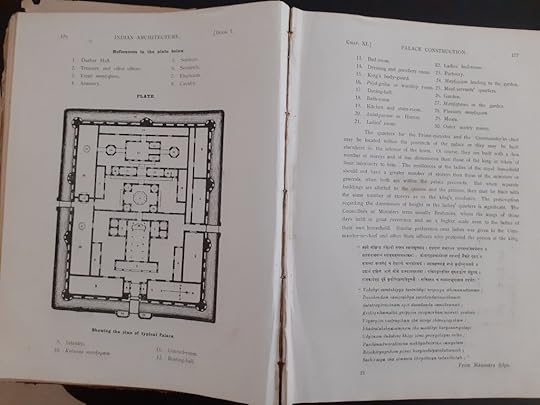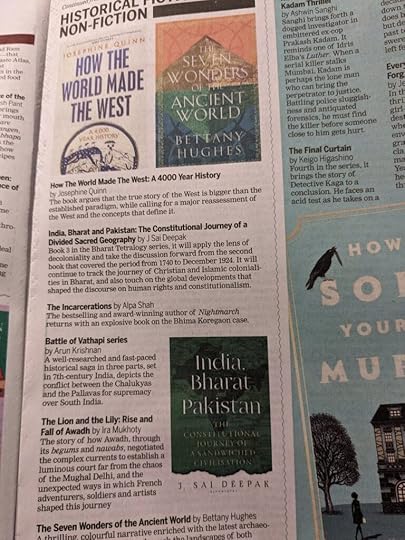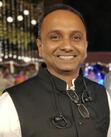Arun Krishnan's Blog
July 16, 2024
Chennai launch of The Battle of Vathapi trilogy
The launch of The Battle of Vathapi trilogy was done in Chennai on 13th July, […]
The post Chennai launch of The Battle of Vathapi trilogy first appeared on authorarunkrishnan.com.
June 9, 2024
How the first history chapter Indian students read, must be written!
An attempt at how our history should be taught to our school students. I imagine how the first chapter ought to be written.
The post How the first history chapter Indian students read, must be written! first appeared on authorarunkrishnan.com.
June 3, 2024
Terrain dictates tactics. Geography dictates history!
Ever wondered why wave after wave of attacks on India, always happened from the northwest, […]
The post Terrain dictates tactics. Geography dictates history! first appeared on authorarunkrishnan.com.
May 29, 2024
Writing the last chapter, FIRST!
Why I chose to write the last chapter of Simha's Roar, first.
The post Writing the last chapter, FIRST! first appeared on authorarunkrishnan.com.
March 4, 2024
How do you write a scene, they ask.
I have been asked this question often enough. How do you write? Do you plan […]
The post How do you write a scene, they ask. first appeared on authorarunkrishnan.com.
February 27, 2024
Research and Historical Fiction
 Layout of a Palace
Layout of a PalacePeople often ask me how I do my research for my books. Any genre, even those seemingly not requiring much research, like romance, do need the author to carry out some research. In romance, research could be about places. With thrillers, it could be about places, government organisations and their structure, weaponry and a host of other things.
So what does research mean for writers of historical fiction?
Let me illustrate with how I did it for The Battle of Vathapi series. The first stop for most writers of historical fiction are books on history. Authentic books on history. For The Battle of Vathapi, I started off with the History of South India by K. A. Neelakanta Sastri., the doyen of South Indian history and historical research. Since most of the action is set in South India, this seemed like a reasonable starting point. However, the action also moves up north, to Ujjain. I bought the entire 11 volume set titled The History and Culture of the Indian People by R. C. Majumdar. This set is a must have for all lovers of Indian history and who would like to use it as a reference manual.
I also looked at the Mahavamsa, the chronicles that contain the history of Buddhism in Sri Lanka. Quite a bit of action in The Battle of Vathapi trilogy is set in Sri Lanka and it was important to get the names and time periods of the various kings right.
The biggest advantage an author has, in this day and age, is the internet. And search engines. There is so much easy information available on the web. Add to that the presence of software like Google Maps which allows one to easily look at geographical contours and features and calculate distances between places. It makes the job of modern authors so much easier than what say, Mr. Kalki would have had to do when he was writing the Ponniyin Selvan and other books in the 50s.
So what are the kinds things that historical fiction authors look for, when they carry out research? The main aspects that I look for, are the following:
Historical Facts – Historical facts could include the names of kings and queens, battles that they have fought, buildings / temples that they have built, their allies, their sons and daughters, the generals and ministers who aided them. I also often look at lists of the king names from an era and derive names of characters from old dead kings. Coming up with character names that are suitable for a given period is critical and very difficult. Looking up names of kings allows me easy access to names that I can then modify as required. Saves me a lot of time eventually.Places – The old names of places need to be used in historical novels. What were the places like? Sometimes there are descriptions of places like say, Kalidasa’s description of Ujjain in Meghadutam. There might be inscriptional evidence available that talk about land grants, villages, palaces and temples that existed during a particular time. The historical fiction author, during his world-building must make use of this information to give his readers a feel for what the places might have looked like.Buildings – What kinds of buildings were there during those times? What architecture was used for building temples? How were palaces laid out? Cities? There is a wealth of information available on all these aspects.Food – The food that people ate during a particular period in time. Again, to immerse the reader in an era, it is important to help the reader understand the kinds of food that were eaten.Attire – What did the men and women wear in that time period? During times of peace. At war. Climate – What was the climate like during the time of the year? Vegetation – What kinds of plants and trees are grown in the different regions?Culture – What were the dominant religions? What were their festivals? How did they celebrate them? Were the temples we see now, existing then? If so, did they look the same? Different?Weaponry and Tactics – What weapons were used during those times? Were their mechanical instruments? What about siege engines? Magonels. Catapults. What tactics were used in war? What kinds of strategies — offensive and defensive — were used then? Was there gunpowder available? Or some mixture that could be used to start a fire or as an explosive?These and more are what I look for when I research a time period, prior to starting out on my story.
Finally, there is no better research than visiting the places that one is writing about. For The Battle of Vathapi, I visited most of the places that appear. Sigiriya, Pollonoruwa (which I used as a substitute for Anuradhapura), Vathapi, Mahabalipuram, Aihole, Pattadakkal. It is important to visit places since it gives an author the lay of the land.
As you can see, there is a method to the madness you read in a historical fiction novel. Hopefully, I have given you a glimpse of the hard work that goes into writing the books that I write.
The post Research and Historical Fiction first appeared on authorarunkrishnan.com.
January 31, 2024
Why did I start writing historical fiction?

Like every young Indian boy, growing up in the 70s and 80s, I heard stories from my grandmothers. Those stories were mostly from the Ramayana and the Mahabharata. Naturally, the next stop for any young boy in those pre-TV, pre-internet days, was the Amar Chitra Katha. I read voraciously from them, keeping track of any issues that I might have missed. That was my first brush with history. With kings and queens about whom I might otherwise never had heard.
History that I was taught in school didn’t really grip, though. The teachers either didn’t know much or were completely uninterested in the topic that they were supposed to teach. Until, Class 7. We finally got a young teacher, probably just out of college, who actually loved history. She went from Haldia, the little town that we lived in, to Calcutta, to the National Musuem and copied down the entire Ashokan inscription there (the same one you see at the top of this article), got its translation and wrote the entire script out on the blackboard. She made us learn it and even quizzed us on it in the exam. Now, that, was a teacher, with passion for her subject.
The other reason for my interest in history has to be the Big Temple in Thanjavur. My father hails from there and everytime we used to go there, no visit was complete without the obligatory trek to the temple. While I was awestruck by the architecture and the huge Nandi in front, I was even more interested in the slanting, bent-out-of-shape, Nandi to the left of the temple. My mind would start making up stories about why that Nandi had been abandoned by the kings.
I would imagine Raja Raja Chola walking through those precincts and up the stairs to the garbagriha. Tamil Nadu, of course, is FULL of such old and ancient temples and visiting some of these old temples became an obsession with me. I wasn’t (and am still not) a believer, but, a strange sort of calmness would descend on me in these old, ancient temples.
I have always been a voracious reader and historical fiction, was a genre that interested me. Les Miserables, The Count of Monte Christo and The Man in the Iron Mask were the first three that I had read in this genre. However, it was only when I managed to read Kalki’s Ponniyin Selvan, Sivagamiyin Sabatham and Parthiban Kanavu, that I truly got besotted by this genre. Kalki brought to life that distant era. I hated for those books to end as I bid adieu to the many characters with whom I had spent days and months.
However, the switch from reading to writing historical fiction, only happened after I read Amish’s Meluha series. An irresistible urge to write came over me. That urge, luckily, shows no signs of dying down.
The post Why did I start writing historical fiction? first appeared on authorarunkrishnan.com.
January 28, 2024
The Battle of Vathapi series makes it to the Indian Express reading list for 2024!

The Battle of Vathapi series makes it to the Indian Express Reading list for 2024!
The post The Battle of Vathapi series makes it to the Indian Express reading list for 2024! first appeared on authorarunkrishnan.com.
January 27, 2024
Varaha’s Vengeance Pre-orders available!
The pre-orders for Varaha’s Vengeance, the third book in The Battle of Vathapi trilogy are now live at: Amazon.
The post Varaha’s Vengeance Pre-orders available! first appeared on authorarunkrishnan.com.



